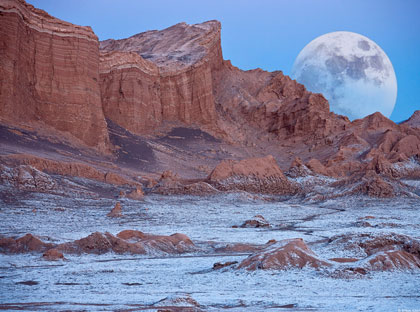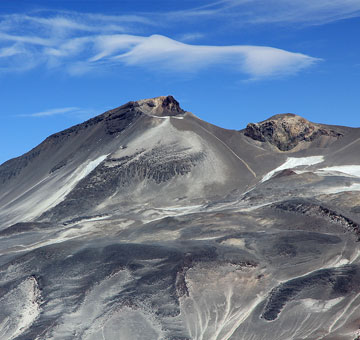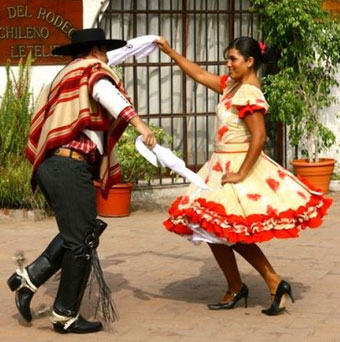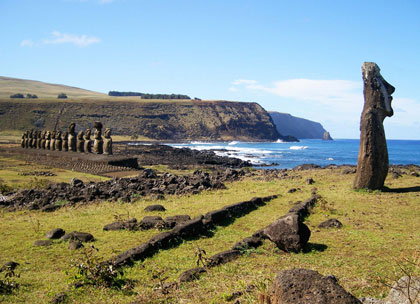Chile
Country statistics

Land area: 289,112 sq miles (748,800 sq km)
Total area: 292,260 sq miles (756,950 sq km)
Population (2012 est.): 17,067,396 (growth rate: 0.88%); birth rate: 14.28/1000; infant mortality rate: 7.36/1000; life expectancy: 78.1; density per sq km: 21
Capital City: Santiago
Monetary unit: Chilean Peso
Languages: Spanish
Ethnicity/race: white and white-Amerindian 95%, Amerindian 3%, other 2%
Religions: Roman Catholic 89%, Protestant 11%, small Jewish population
Country introduction

Chile is a country in South America occupying a long, narrow strip of land between the Andes mountains to the east and the Pacific Ocean to the west. It borders Peru to the north, Bolivia to the north-east, Argentina to the east, and the Drake Passage in the far south. Chilean territory includes the Pacific islands of Juan Fernández, Salas y Gómez, Desventuradas and Easter Island.
Chile stretches over 4,630 km (2,880 miles) north to south, but only 430 km (265 miles) at its widest point from east to west. This encompasses a remarkable variety of landscapes. In the south and center of the country, the Antarctic Humboldt Current produces cooler temperatures, while towards the north temperatures rise due to tropical currents. Cities stretch along the coast, including Valparaíso, Arica and Antofagasta. Much of Chile's coastline is rugged, with surf that seems to explode against the rocks lying at the feet of steep banks. This collision of land and sea gives way every so often to lovely beaches of various lengths, some of them encased by the steep banks.
Moving inland, the coastal mountain range rises near the city of Arica in the north, and extends to the Taitao Peninsula in Patagonia. Its length is divided by rivers which flow out to the sea, and its highest point is 3,000m (9,842 ft) in the Sierra Vicuña Mackenna, just south of Antofagasta. About 80% of the land in Chile is made up of mountains where most of the people live.
Between the Coastal Range and the Andes lies the central depression, consisting of valleys and plains. The landscape and climate in this depression is extremely diverse, stretching from the desert zones in the north to the forests and lakes in the south, including the largest lake in Chile, Lago Llanquihue. Most of Chile's major cities are found in the central depression, as the climates and flatter terrain are more suitable for urban growth.

The Andes range is the backbone of Chile. It is the continuation of a mountain range that emerges in Colombia and which has, between the north of Chile and Santiago, an average height of 5,000m (16,404 ft) above sea level. South of Santiago it begins to descend until it vanishes in the continent's extreme south. It rises up again in the Antarctic, where it is called the Antartandes or the Antarctic Andes. Its most outstanding peaks are located in the north and center of Chile. These are the volcanoes Llullaillaco (6,739 m / 22,109 ft), Tres Cruces (6,749 m / 22,142 ft), Cerro Tupungato (6,635 m / 21,678 ft) and the highest volcano on the planet, Ojos del Salado (6,893 m / 22,614 ft). In the extreme south, where the Patagonian Andes emerge, the most outstanding peaks are the renowned and beautiful horns of Torres del Paine and Mount Fitz Roy.
The culture

Chilean culture is largely influenced by the European heritage with a mix of indigenous ancestry. Only about 7% of the population are indigenous groups. Despite the various Spanish, German, French, or other ancestries of the Chilean people, a very strong sense of patriotism and national identity remains.
Dance is a prominent part of Chilean culture. Their national dance is called the Cueca, which involves dancers waving handkerchiefs above their heads whilst moving in semicircles back and forth, and turning towards the partner and then away. The dance was developed in 1824, but it wasn't declared the official dance of Chile until September, 1979. Chile's national song is known as the Tonada, which is typically a simple "monotonous" slow-moving song with a melancholy theme. The Chilean music scene was influenced by the Spanish colonists.
The Chileans are particularly renowned for their diverse and unique literature and is home to a few Nobel Prize poets including Gabriela Mistral and Pablo Neruda. Also a number of contemporary Chilean authors have gained recognition around the world including Isabel Allende, the author of the House of Spirits, and Eva Luna, the author of Love and Shadows.
Most Chilean holidays center around religious celebrations. As most people are Roman Catholic, the important observances are around Christmas and Easter. Christmas is celebrated in much the same way as it is in North America, but the activities are influenced by the summer weather. New Years Eve is celebrated everywhere, of particular interest is the outdoor festival in Valparaiso. Independence Day (from Spain) is a national holiday which features picnics and folk dancing. On this day the public parks are filled with stands called Fondas, decorated with leaves. Empanadas or meat turnovers and chicha, drinks made of fermented grapes are served and guitar music accompanies the cueca, the national folk dance.
The fact that Chile is spread over a diverse typographical landscape gives it an abundant variety of products to experiment with. Seafood is particularly popular in Chile due to the abundance of fish like Chilean sea bass and salmon. Furthermore a unique flavor has come into being with the fusion of local ingredients with Spanish traditions that came with the colonists. European immigration in great numbers has also had an impact on the cuisine culture of Chile. The Germans and Italians have also had a profound influence on the cooking styles and traditions of the country.
Soccer is the game of choice for the Chileans. People from all circles of life participate in this sport and the country is also home to a number of world renowned stadiums. Skiing is another widely practiced sport followed by surfing and basketball in terms of popularity.
Attractions & landmarks

The Atacama Desert of Northern Chile is one of the most unique places in the world and is an attraction not to miss. The desert is completely barren, consisting mostly of a rainless plateau, running from the Pacific Ocean to the Andes Mountains. The average width is less than 160 km (100 miles), but it extends 965 km (600 miles) south from the Peruvian border. It is also one of the most driest regions in the world, averaging less than 0.004 inches (0.01 cm) of rain per year.
The Patagonia region in Chile is another mesmerizing place to visit that boasts some of the most dramatic landscapes on Earth. Located at the southern end of South America and shared with Argentina, the region offers views of dazzling fjords and extremely steep Andean peaks that have turned the slim swath of land into a playground for skiing, whitewater rafting and trekking. The Torres del Paine National Park is the most popular attraction in this region that encompasses mountains, a glacier, a lake, and river-rich areas of the Chilean Patagonia. Pumas, guanacos, and a wide variety of birds can also be found here.
The capital, Santiago is the cultural center of the country and has many museums, events, theaters, restaurants, bars and other entertainment. There is great nightlife in an area called Bellavista and many wineries nearby. Great views of the the city can be enjoyed from the two hills in the city, St. Lucia and St. Kitts. Santiago's alluring feature are its large municipal markets, which sell a vast array of food products. Two of the city's markets, the massive Mercado Central and La Vega fruit market are particularly worth exploring. Chile is also host to the world's largest outdoor pool, which can be found at the Alfonso Del Mar Resort in Algarrobo, about a 2 hour drive from the capital.

Three fascinating islands are found in the Pacific Ocean. There is the isolated Easter Island that lies 3,510 km (2,180 mi) west off the coast of Chile and is renowned for the the world famous mysterious statues. Then there is Robinson Crusoe, 400 miles (570 km) off the coast of Chile, an island that was named after the Daniel Defoe novel, which was inspired by the incident of Alexander Selkirk, a sailor who was marooned there in 1705 for four years and four months. Finally, Chiloé, a charming enclave in the South Pacific that has an interesting architecture and is full of myths and natural beauty.
Visiting Chilean wineries is very popular and some regions have interesting tourist infrastructure to host wine lovers from all over the world. There are 188 wineries in Chile, of which 96 are devoted to tourism, 14 have restaurants and nine provide accommodation. Forty are found just outside of Santiago. Among the 15 different valleys that produce wine in Chile, some of the more notable ones are Casablanca, Maipo, San Antonio/Leyda, Cachapoal, Colchagua, Curico and Maule.
Chile's beaches are a major draw for international and domestic tourism alike. During the summer months of December through March, families from all over the country come to relax along the windswept coast near Viña del Mar and Valparaíso, sharing asado (Chilean barbecue) and enjoying the bounty of fresh seafood provided by the freezing waters of the Humboldt Current.